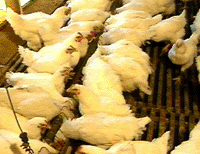Strategy For Animal Feeding Operations Likely Discussion Topic For State's Lawmakers
Strategy For Animal Feeding Operations Likely Discussion Topic For State's Lawmakers

A strategy recently released by the federal EPA and USDA has likely ensured that the issue of confined animal feeding operations will be a topic of discussion this year for Kentucky lawmakers.
This broad strategy, called the Unified National Strategy for Animal Feeding Operations, sets forth guidelines for livestock operations to help them protect the environment. To comply with this federal strategy, states must now devise their own plans that meet or exceed federal guidelines. Kentucky's Natural Resources Cabinet has proposed a plan for Kentucky that will be submitted for legislative review.
"The plan proposed by the cabinet is called the Kentucky Animal Feeding Operation/Confined Animal Feeding Operation strategy, or AFO- CAFO strategy," said Richard Coffey, University of Kentucky Cooperative Extension Specialist in animal science. "This strategy will take into account not only swine operations, but also operations with dairy cattle, poultry, and beef cattle as well."
According to Coffey, a state must follow the federal strategy as a bare minimum, but may choose to make regulations even stricter if deemed appropriate. He said the purpose behind the federal strategy is protecting surface water resources from pollution, and that few people would disagree with that idea. But exactly how individual states go about planning and implementing their strategies is the more difficult part of the process.
"The devil is in the details," said Coffey. "At this point, the federal strategy is still somewhat conceptual, with many details yet to be worked out. For example, one component states that operations must develop a comprehensive nutrient management plan for utilizing manure." Coffey said this will involve such things as manure and soil testing, matching application rates with crop needs, and choosing a method of application.
"The specifics on how to address each of these issues are not defined," he said.
Coffey said the current proposal from the Resources Cabinet differs from the federal plan in at least two areas -- integrator liability, and "setback" regulations.
With integrator liability, both the contractors and the individuals with whom they contract are jointly liable for the conditions of the permit," said Coffey. "With the setbacks, the Cabinet has set forth specific setback distances for construction of animal facilities and land application of manure."
Coffey said producers throughout the state will want to stay informed about any discussions concerning confined animal feeding operations.
"The question Kentuckians will have to deal with is do we simply adopt the guidelines outlined in the federal strategy, or do we go with something more stringent," said Coffey.
He advised producers to stay in touch with state legislators and other agricultural leaders to learn of opportunities to participate in these discussions. Those with computer Internet connections may wish to check legislative schedules and agendas found on various state government websites.
